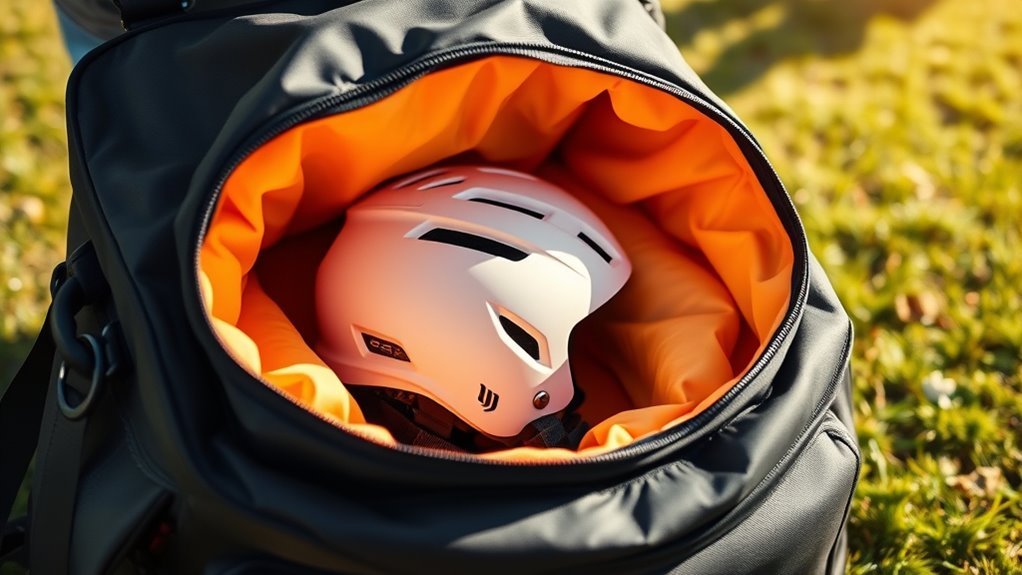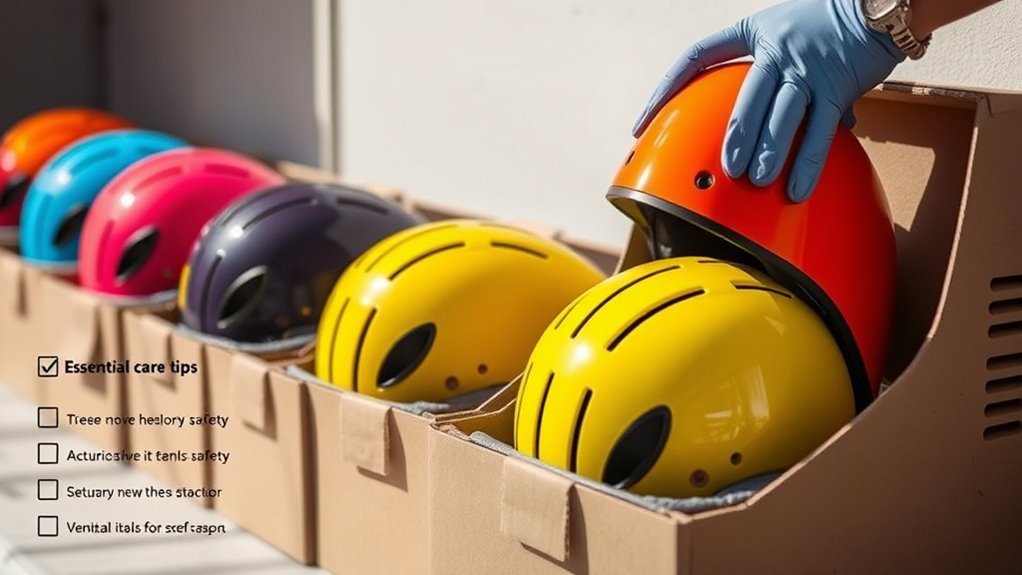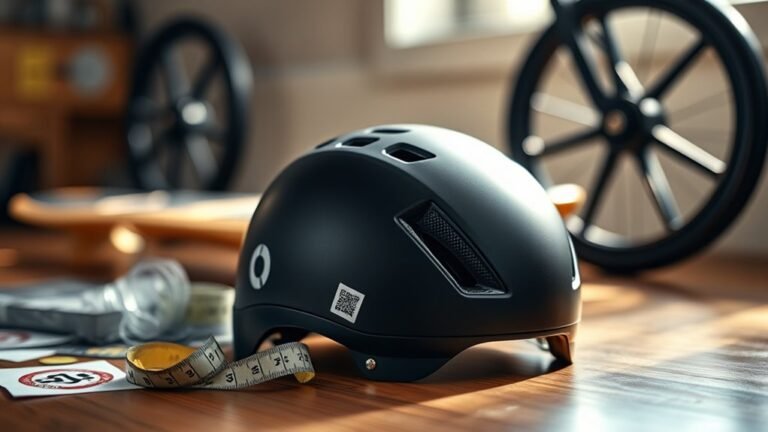Best Practices for Transporting Helmets Safely
To transport helmets safely, choose a padded or hard case that fits snugly. Clean helmets with mild soap, avoiding harsh chemicals. Always secure them to prevent movement during transit. Keep helmets in a climate-controlled environment, avoiding extreme temperatures. For team sports, use dedicated bags that minimize impact. Before and after transport, inspect for damage or wear. With these best practices, you’ll effectively guarantee helmet safety and care. Discover additional tips for enhanced protection and maintenance.
Understanding Helmet Materials and Their Vulnerabilities

When you’re transporting helmets, it’s essential to understand the materials they’re made from and their specific vulnerabilities. Helmets typically use materials like polycarbonate, fiberglass, and expanded polystyrene (EPS). Each of these material types has unique characteristics and weaknesses. For instance, polycarbonate is lightweight but can scratch easily, while fiberglass offers durability but can be more prone to cracking under impact. Vulnerability factors also include temperature extremes and moisture exposure, which can degrade the protective qualities of helmets over time. Knowing these aspects helps you take necessary precautions during transport, ensuring that your helmets remain in prime condition. By being aware of these material vulnerabilities, you’re better equipped to maintain the integrity of your helmets and enjoy your freedom on the road or trail.
Choosing the Right Transport Bag

Selecting the right transport bag for your helmets can make all the difference in maintaining their condition. Consider both transport bag materials and bag size considerations to guarantee protection during travel.
| Material | Pros | Cons | Size Consideration | Ideal Use |
|---|---|---|---|---|
| Nylon | Lightweight, durable | Less impact-resistant | Fits most helmet types | Daily commuting |
| Canvas | Sturdy, water-resistant | Heavier than nylon | Choose based on helmet size | Long-distance travels |
| Neoprene | Shock-absorbent | Bulkier | Snug fit for snug helmets | Extreme sports |
| Polyester | Affordable, versatile | May wear over time | Check dimensions | Casual use |
| Leather | Premium feel, durable | Higher cost | Custom sizes available | Luxury transport |
Choose wisely!
Cleaning and Preparing Helmets for Transport

After choosing the right transport bag, it’s time to focus on cleaning and preparing your helmets for travel. Proper helmet maintenance is vital for guaranteeing safety and longevity. Start by using gentle cleaning techniques, like a soft cloth and mild soap, to wipe away dirt and grime. Avoid harsh chemicals that could damage the helmet’s materials. Pay special attention to the interior padding; consider using a diluted vinegar solution to freshen it up if needed. Verify the helmet is completely dry before packing to prevent mold and unpleasant odors. Finally, inspect for any signs of wear or damage. Taking these steps makes your helmets ready for the journey while keeping them in top condition for your next adventure.
Properly Securing Helmets During Transit
Securing helmets during transit is essential to prevent damage and guarantee they remain in peak condition. Start by using proper helmet storage solutions, like padded bags or hard cases, to protect them from impacts. When loading your helmets, make sure they’re snugly fit to avoid movement that could cause scratches or dents. If you’re stacking helmets, place soft materials between them to absorb shocks. Always secure straps or buckles to keep the helmets in place. Remember, helmet safety relies not just on usage but also on how you transport them. By taking these precautions, you’ll ascertain your helmets stay safe and ready for action, giving you the freedom to enjoy your adventures without worry.
Avoiding Temperature Extremes
When transporting helmets, it’s essential to keep them within an ideal temperature range to maintain their integrity. Exposure to extreme heat can weaken materials, while cold weather can make them brittle. By avoiding these temperature extremes, you guarantee your helmets provide the protection they’re designed for.
Ideal Temperature Range
To keep your helmet in ideal condition, it is vital to avoid exposing it to extreme temperatures. Helmets function best within a specific ideal temperature range, typically between 50°F and 100°F (10°C to 37°C). Extreme heat or cold can compromise their thermal stability, leading to potential damage that might not be immediately visible. If you leave your helmet in a hot car or a freezing garage, you’re risking its integrity. Always transport your helmet in a climate-controlled space when possible. By doing this, you guarantee your gear remains reliable, giving you the freedom to ride with confidence. Protect your investment and enjoy your adventures without the worry of compromised safety due to temperature extremes.
Impact of Heat
While you might not notice immediate damage, exposing your helmet to excessive heat can greatly impact its structural integrity. Heat damage can weaken materials, leading to reduced protection during impacts. It’s essential to understand the temperature effects on your gear. Here’s a quick reference:
| Temperature Range | Potential Damage |
|---|---|
| 0°F – 100°F | Minimal impact |
| 100°F – 140°F | Softening of materials |
| 140°F – 180°F | Deformation possible |
| 180°F – 220°F | Structural compromise |
| 220°F and above | Total failure likely |
Always store your helmet in a cool, dry place to avoid these risks. Protect your investment and guarantee your safety by being mindful of heat exposure.
Cold Weather Considerations
As temperatures drop, it’s crucial to be mindful of how cold weather can affect your helmet’s performance. Cold weather effects can compromise the helmet’s insulation, reducing its effectiveness in protecting your head. When transporting your helmet, avoid exposing it to extreme cold for prolonged periods. This can weaken the materials and diminish their protective qualities. If you’re storing your helmet in a vehicle, keep it in a temperature-controlled environment whenever possible. Consider wrapping it in an insulated bag to provide an extra layer of protection against frigid air. By taking these precautions, you guarantee your helmet maintains its integrity and readiness for your next adventure, allowing you the freedom to ride without worry.
Storing Helmets in Vehicles
When storing helmets in your vehicle, proper placement is key to maintaining their integrity. Avoid exposing them to excessive heat by choosing a shaded area or a cooler compartment. Secure storage solutions can help prevent damage and guarantee your helmets are ready for use when you need them.
Proper Helmet Placement
To guarantee your helmet remains in prime condition during transport, it’s crucial to store it properly in your vehicle. Always place your helmet in an upright position, confirming the helmet orientation is correct. This prevents unnecessary pressure on the cushioning, which can compromise its protective qualities. Avoid tossing your helmet in the trunk or leaving it loose on the seat, as this can lead to impacts that damage its structure. Instead, use a dedicated storage space, like a helmet bag or a secure compartment, to maintain its integrity. Remember, keeping your helmet safe not only preserves its lifespan but provides optimal protection when you hit the road, allowing you the freedom to ride without worry.
Avoiding Excessive Heat
Exposing your helmet to excessive heat can greatly weaken its materials and reduce its effectiveness. To avoid this, consider these key practices for storing helmets in vehicles:
- Temperature Monitoring: Use a thermometer to keep track of the inside temperature of your vehicle. Aim to keep it below 100°F (38°C).
- Heat Insulation: Invest in insulated storage bags or containers that help shield your helmet from direct sunlight and heat.
- Smart Placement: Never leave your helmet on the dashboard or other sun-exposed areas. Instead, store it in a shaded compartment or under a seat.
Secure Storage Solutions
Although helmets are designed to withstand impact, improper storage can compromise their integrity. When storing helmets in your vehicle, consider effective helmet storage solutions to keep them safe. Always use protective covers to shield your helmet from dirt, moisture, and UV rays. Avoid leaving helmets in direct sunlight or hot areas, as excessive heat can weaken the materials. Securely store your helmet in a dedicated compartment or a padded bag to prevent it from rolling around and getting damaged. If you’re transporting multiple helmets, stack them carefully, ensuring they don’t touch one another. By taking these simple precautions, you can maintain the safety and longevity of your helmets, allowing you to embrace your freedom on the road with confidence.
Transporting Helmets for Team Sports
When you’re transporting helmets for team sports, ensuring their safety and integrity is essential. Proper helmet transport logistics can prevent damage and extend the life of your gear. Here are three key considerations:
- Use Dedicated Gear Bags: Invest in padded bags designed specifically for helmets to minimize impact during transport.
- Secure Each Helmet: Make sure each helmet is fastened or secured within the bag to prevent movement and collisions.
- Monitor Temperature: Avoid leaving helmets in extreme temperatures, as this can compromise their structural integrity.
Best Practices for Shipping Helmets
Shipping helmets requires careful attention to detail to guarantee they arrive in ideal condition. Start by choosing appropriate packaging materials that cushion and protect your helmets. Use sturdy boxes that can withstand the rigors of transport, and make sure your helmets are wrapped in bubble wrap or foam padding to prevent any movement inside the box. Label your packages clearly, indicating that they contain fragile items, to alert handlers. It’s also wise to take into account the shipping method—opt for a service that provides tracking and insurance for added peace of mind. By following these best practices for helmet shipping, you’ll make certain your gear reaches its destination safely, allowing everyone to enjoy the freedom of riding without worry.
Checking Helmets Before and After Transport
Before and after transporting your helmets, it’s essential to inspect them for any damage. A thorough check helps guarantee safety and performance. Additionally, cleaning the helmets before storing them will keep them in ideal condition for future use.
Inspect for Damage
Although it may seem tedious, inspecting helmets for damage both before and after transport is vital to guaranteeing their safety and effectiveness. Doing so helps maintain the helmet’s lifespan and identifies any damage indicators that could compromise performance. Here’s what to look for:
- Cracks or dents – Check the outer shell for any visible cracks or dents that could weaken the structure.
- Padding condition – Verify the inner padding hasn’t degraded, as this impacts comfort and protection.
- Strap integrity – Examine the straps for fraying or damage, as they play an important role in securing the helmet.
Clean Before Storing
Once you’ve inspected your helmets for any damage, cleaning them is the next step in guaranteeing their longevity and performance during transport. Prioritize helmet hygiene by using a mild soap and water solution to wipe down both the exterior and interior. Pay special attention to the padding, as it can harbor sweat and bacteria. After cleaning, make sure the helmet is completely dry before storing it. For effective storage solutions, consider using a breathable bag or dedicated helmet case to protect against dust and moisture. This not only keeps your helmet in peak condition but also extends its life. Remember, a clean helmet isn’t just safer; it enhances your riding experience, allowing you to feel free and confident on the road.
Educating Others on Helmet Safety and Care
While many people understand the importance of wearing a helmet, fewer are aware of how to properly care for and maintain it. Educating others on helmet safety awareness and sharing helmet care tips can greatly improve safety in your community. Here are three essential practices to share:
- Inspect regularly: Check for cracks, frayed straps, or any signs of damage before each use.
- Clean properly: Use mild soap and water to clean your helmet, avoiding harsh chemicals that can weaken its integrity.
- Store safely: Keep helmets in a cool, dry place away from direct sunlight, preventing deformation and deterioration.
Frequently Asked Questions
How Often Should Helmets Be Replaced After Transport?
You should replace helmets every 3 to 5 years, regardless of transport. It’s essential to follow replacement frequency guidelines, as helmets can degrade over time, even if they’re not visibly damaged. If you’ve been in an accident or dropped your helmet during transport, it’s wise to replace it immediately. Always prioritize safety by regularly checking for wear and tear, ensuring your helmet’s protection remains effective during your adventures.
Can Helmets Be Transported in Backpacks?
Yes, you can transport helmets in backpacks, but you need to prioritize helmet storage and backpack safety. Make certain the helmet fits securely inside your bag without being crushed or deformed. Use a dedicated compartment if available, and avoid placing heavy items on top to maintain its shape. Always check for any damage after transport, as even minor impacts can compromise safety. Proper care guarantees your helmet remains effective when you need it most.
What Materials Should I Avoid When Transporting Helmets?
When you’re carrying a helmet, think of it as a knight’s armor—vital for protection. Avoid materials that can crush or compress the helmet’s structure, like hard plastic or metal transport containers. Instead, opt for soft, padded cases that safeguard the protective padding. This way, you guarantee your helmet remains intact and ready to defend you. Treat it with care, and it’ll serve you well on the journey ahead.
Is It Safe to Stack Helmets During Transport?
No, it isn’t safe to stack helmets during transport. Helmet stacking can compromise their structural integrity, increasing the risk of damage. Each helmet’s design is meant to absorb impact individually, and stacking them can lead to misalignment or crush points. For transport safety, always store helmets in a single layer, ideally in protective bags or containers. Ensuring your gear’s safety means you can focus on enjoying your ride without worry.
How Do I Check for Damage After Transport?
After transport, you should perform a post transport inspection to check for any damage indicators. Look for cracks, dents, or any deformation in the helmet’s shell. Inspect the inner foam padding for compression or tears, as these can compromise safety. Don’t forget to examine the straps and buckles for any wear or fraying. If you notice significant damage, it’s best to replace the helmet to guarantee your safety on your next ride.






